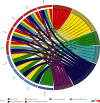A Bioinformatics Research on Novel Mechanism of Compound Kushen Injection for Treating Breast Cancer by Network Pharmacology and Molecular Docking Verification
- PMID: 32849897
- PMCID: PMC7439201
- DOI: 10.1155/2020/2758640
A Bioinformatics Research on Novel Mechanism of Compound Kushen Injection for Treating Breast Cancer by Network Pharmacology and Molecular Docking Verification
Abstract
Compound Kushen injection (CKI) has been extensively used in treating breast cancer (BC). However, the molecular mechanism remains unclear. In this study, 16 active compounds of CKI were obtained from 3 articles for target prediction. Then, a compound-predicted target network and a compound-BC target network were conducted by Cytoscape 3.6.1. The gene ontology (GO) enrichment analysis and Kyoto Encyclopedia of Genes and Genomes (KEGG) pathway enrichment analysis were performed on the DAVID database. The binding energy between the key targets of CKI and the active compounds was studied by molecular docking. As a result, 16 active compounds of CKI were identified, corresponding to 285 putative targets. The key targets of CKI for BC are HSD11B1, DPP4, MMP9, CDK1, MMP2, PTGS2, and CA14. The function enrichment analysis obtained 13 GO entries and 6 KEGG pathways, including bladder cancer, cancer pathways, chemical carcinogenesis, estrogen signaling pathway, TNF signaling pathway, and leukocyte transendothelial migration. The result of molecular docking indicated that DPP4 had strong binding activity with matrine, alicyclic protein, and sophoridine, and MMP9 had strong binding activity with adenine and sophoridine. In conclusion, the therapeutic effect of CKI on BC is based on the overall pharmacological effect formed by the combined effects of multiple components, multiple targets, and multiple pathways. This study provides a theoretical basis for further experimental research in the future.
Copyright © 2020 Shuyu Liu et al.
Conflict of interest statement
All the authors declare that there are no conflicts of interest.
Figures







Similar articles
-
Study on the mechanisms of compound Kushen injection for the treatment of gastric cancer based on network pharmacology.BMC Complement Med Ther. 2020 Jan 15;20(1):6. doi: 10.1186/s12906-019-2787-y. BMC Complement Med Ther. 2020. PMID: 32020871 Free PMC article.
-
Exploring the pharmacological mechanism of compound kushen injection in the treatment of breast cancer using in vitro experiments: Coupling network pharmacology with GEO database.Front Oncol. 2022 Aug 9;12:946758. doi: 10.3389/fonc.2022.946758. eCollection 2022. Front Oncol. 2022. PMID: 36016606 Free PMC article.
-
Mechanisms of Compound Kushen Injection for the treatment of bladder cancer based on bioinformatics and network pharmacology with experimental validation.Chin J Nat Med. 2022 Jan;20(1):43-53. doi: 10.1016/S1875-5364(22)60144-4. Chin J Nat Med. 2022. PMID: 35101249
-
Network Pharmacology-Based Study on the Molecular Biological Mechanism of Action for Compound Kushen Injection in Anti-Cancer Effect.Med Sci Monit. 2020 Jan 1;26:e918520. doi: 10.12659/MSM.918520. Med Sci Monit. 2020. PMID: 31892693 Free PMC article.
-
Efficacy of Compound Kushen Injection in Relieving Cancer-Related Pain: A Systematic Review and Meta-Analysis.Evid Based Complement Alternat Med. 2015;2015:840742. doi: 10.1155/2015/840742. Epub 2015 Oct 4. Evid Based Complement Alternat Med. 2015. PMID: 26504481 Free PMC article. Review.
Cited by
-
Cell cycle arrest is an important mechanism of action of compound Kushen injection in the prevention of colorectal cancer.Sci Rep. 2022 Mar 14;12(1):4384. doi: 10.1038/s41598-022-08336-4. Sci Rep. 2022. PMID: 35288618 Free PMC article.
-
A systematic review and meta-analysis on the efficacy of Compound Kushen Injection in 3 kinds of digestive tract tumor.J Gastrointest Oncol. 2021 Dec;12(6):2919-2929. doi: 10.21037/jgo-21-774. J Gastrointest Oncol. 2021. PMID: 35070418 Free PMC article.
-
Meta-analysis of integrated ChIP-seq and transcriptome data revealed genomic regions affected by estrogen receptor alpha in breast cancer.BMC Med Genomics. 2023 Sep 15;16(1):219. doi: 10.1186/s12920-023-01655-z. BMC Med Genomics. 2023. PMID: 37715225 Free PMC article.
-
A System Pharmacology Model for Decoding the Synergistic Mechanisms of Compound Kushen Injection in Treating Breast Cancer.Front Pharmacol. 2021 Nov 16;12:723147. doi: 10.3389/fphar.2021.723147. eCollection 2021. Front Pharmacol. 2021. PMID: 34899291 Free PMC article.
-
Exploration of the Mechanism of Lianhua Qingwen in Treating Influenza Virus Pneumonia and New Coronavirus Pneumonia with the Concept of "Different Diseases with the Same Treatment" Based on Network Pharmacology.Evid Based Complement Alternat Med. 2022 Feb 8;2022:5536266. doi: 10.1155/2022/5536266. eCollection 2022. Evid Based Complement Alternat Med. 2022. PMID: 35145559 Free PMC article.
References
-
- Wu K. R., Zhu Z. H., He Y. X., Huang L., Yan X., Wan D. Efficacy and safety of Xiao Ai Ping Injection combined with chemotherapy in advanced gastric cancer: a systematic review and meta-analysis. Evidence-Based Complementary and Alternative Medicine. 2019;2019:12. doi: 10.1155/2019/3821053.3821053 - DOI - PMC - PubMed
LinkOut - more resources
Full Text Sources
Research Materials
Miscellaneous

